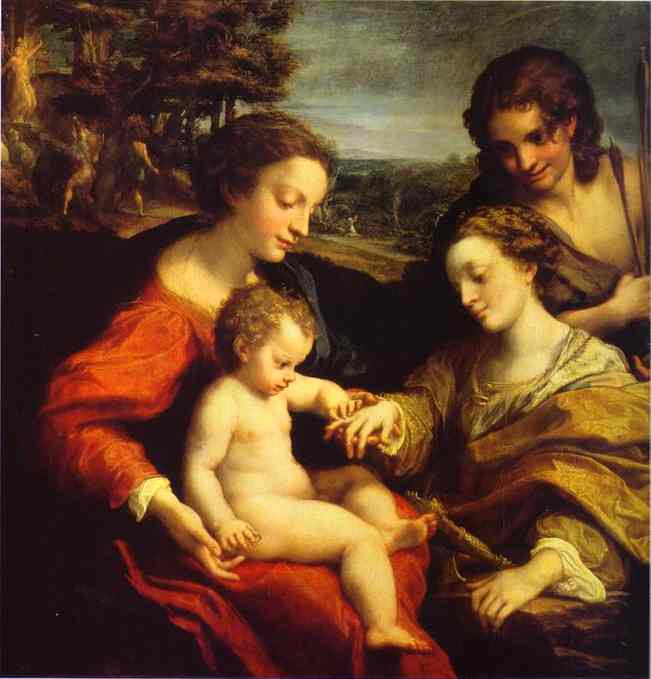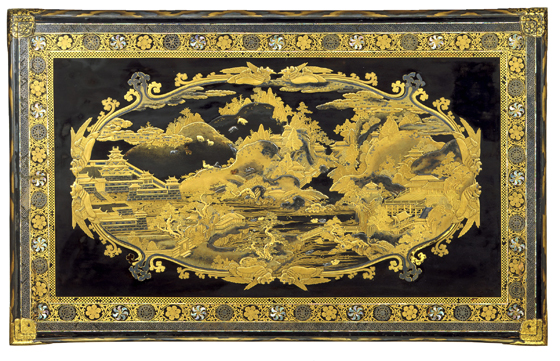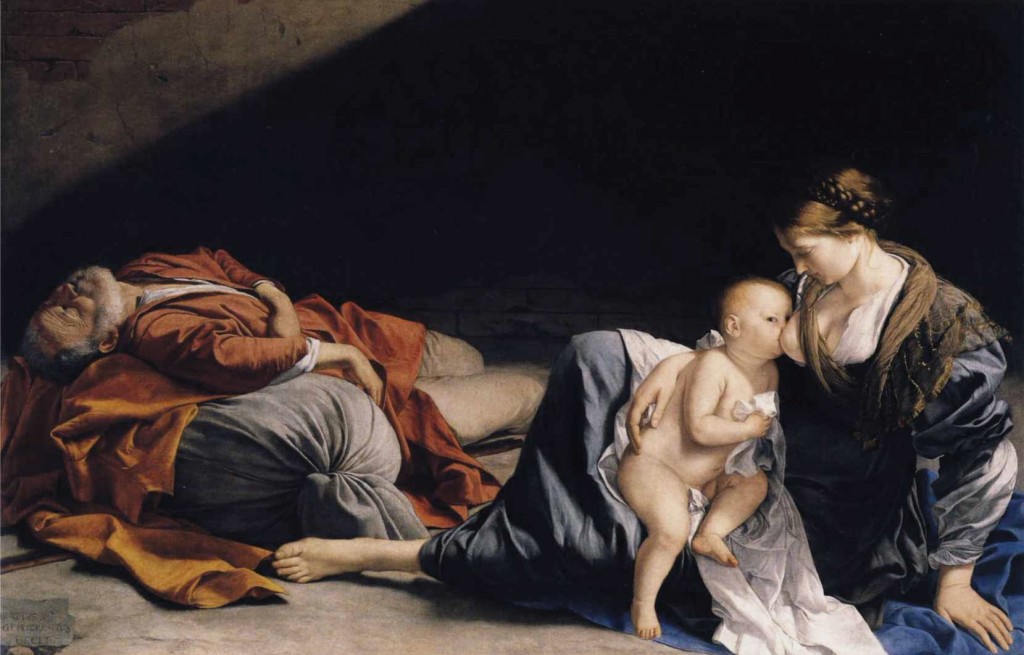Cardinal Mazarin was the real ruler of France during the boyhood of Louis XIV and one of the greatest collectors in the history of art. The Bibliotheque Nationale was once the Cardinal’s private palace. It was here, a few days before Mazarin’s death, that the Duc de Brienne witnessed a scene to touch the heart of any collector. This is his account:

---Cardinal Mazarin showed "to what extent possessions can take possession of the possessor." Before he died, Mazarin shuffled sadly through his collection, wearing a nightcap and camel's-hair wrapper, and left the room saying, "Goodbye, dear pictures that I have loved so well and which have cost me so very much." Read more: http://www.time.com/time/magazine/article/0,9171,780044,00.html#ixzz1b4XKBlmV
I heard him coming from the shuffling of his slippers which he dragged along the floor like a man who is very weak. I hid behind the tapestry and I heard him saying, “I must leave all that.” He stopped and paused at every step because he was very feeble, turning first to one side and then to the other and casting his eyes upon the objects which appeared before him. He said from the depths of his heart, “I must leave all that.” And turning around he added, “and also that. What terrible efforts it has cost me to acquire those things. Can I leave them? Can I abandon them without regret? … I shan’t see them anymore where I am going.”
I heard his words very distinctly, they touched me, possibly more than they might have touched the Cardinal himself… I gave a deep sigh and he heard me. “Who is that?” “It is I, Mon Seigneur, who am awaiting Your Eminence with a letter of great importance which I have just received.” “Come closer come closer” he said in a sad voice. He was undressed, wearing a wrapper of camel’s hair trimmed with fur and his nightcap. “Your eminence would do well to sit down,” I said and was about to take him a chair. “No”, he said, ” I am better off walking. I have things to do in my library.” I gave my arm and he leaned against me. He did not want me to speak yo him of business. “I am no longer in a condition to listen to those things,” he said. …

Read More:http://www.friendsofart.net/en/art/correggio/the-mystic-marriage-of-st-catherine-with-stsebastian;-in-the-background-is-the-martyrdom-of-two-saints The Mystic Marriage of St. Catherine, with St.Sebastian; in the Background is the Martyrdom of Two Saints 1526 - 1527 Musée du Louvre, Paris, France Oil on canvas
And coming back to his original thought, “Look my frien,” he said, ” at that beautiful picture of Correggio and again at that Venus of Titian’s and at Caracci’s incomparable Deluge for I know that you like pictures and that you understand them well. Good bye, dear pictures that I have loved so well and which have cost me so very much.”

caracci. Deluge. Read More:http://bittergracenotes.blogspot.com/2010/05/rainbow-cloud-imbiber-may-be-seen.html
ADDENDUM:
Donald Posner: Shortly before 1662 the comte de Brienne, then only twenty-six years old, formed a collection that boasted, along with the names of Raphael, Domenichino, and Poussin, those of Duirer, Brouwer, Teniers, and Van Dyck;56 Brienne was later to enthuse over a Madonna and Child by Van Dyck: “to my taste it is the most beautiful picture of its kind …,” equal or superior in its qualities, he wrote, to works by Raphael, Titian, and Carracci.57 By the 1670s, the duc de Richelieu, guided by the critic Roger de Piles, began building his great collection of paintings by Rubens. However much Fr art de Chambray railed against them, the modern curzeux, who rejected the narrow focus of a “classical” taste, were well entrenched, and they were not about to go away. Read More:http://www.collegeart.org/pdf/artbulletin/Art%20Bulletin%20Vol%2075%20No%204%20Posner.pdf

Read More: http://www.vam.ac.uk/content/articles/h/history-of-the-mazarin-chest/ ---The Mazarin Chest, renowned as one of the finest pieces of Japanese export lacquer to have survived from circa 1640, is a star item in the V&A's internationally acclaimed collection of Japanese art. It measures 59 cm high, 101.5 cm wide and 63.9 cm deep. It is made of black-lacquered wood lavishly decorated with scenes
the Tale of Genji and the Tale of the Soga Brothers as well as other subject matter.---…The duc de Liancourt paid well for a couple of pictures, one of which he believed to be by Annibale Carracci and the other by Giorgione. They were sold to him, fraudulently, by a fellow collector, Evrard Jabach, but the connoisseur Lom6nie de Brienne recognized them as extremely good counterfeits, made by that “dangerous copyist and rogue,” Sebastian Bourdon. Brienne explained that he was able to spot Bourdon’s manner “in a few folds of drapery.” But Brienne admitted that he himself was occasionally fooled too. So was Jabach-Jabach, possessor of an “eye” believed sharp enough to discover the only two authentic drawings in a group of three hundred attributed to Raphael.

Read More:http://www.garyschwartzarthistorian.nl/schwartzlist/?id=8--- When Cardinal Mazarin died in 1661 as the most powerful man in France, we now learn, he owned a major painting by Rembrandt from about 1639 now in the collection of the Duke of Devonshire at Chatsworth. Art historians call it King Uzziah in the Temple, struck with leprosy, but to the cardinal’s agent it was “the portrait of a Pasha from the hand of this famous Fleming.” Letters to Mazarin from his agent shortly before the cardinal’s death and other documents indicate that the painting was sent to Paris from Rome – how it got there we do not know – where it belonged to Mazarin’s sister. One of the letters tells us that it was Mazarin’s particular wish to own it. If these proofs of Rembrandt’s high standing in Europe in the last decade of his life had been known in the 19th century, the legend of Rembrandt’s rejection by his contemporaries – a legend that was particularly popular in France – might never have gained currency. That is how important archive research can be.---
Connoisseurship was a defense and guide, albeit imperfect, for anyone venturing into the ever widening world of art. By the middle of the century interest in the acquisition, or at least comprehension, of this skill was great enough to suggest the need for a primer, and there appeared in 1649, for the first time in the history of art, a book devoted to the subject of connoisseurship, Abraham Bosse’s Sentimens sur la distznction des diverses manitres de Peinture….( ibid.)

Gentileschi: Rest on the Flight to Egypt. Read More:http://it.wikipedia.org/wiki/File:Orazio_Gentileschi_-_Rest_on_the_Flight_to_Egypt.JPG
…Mistaking one artist’s work for another’s could be costly;Mazarin is reported to have bought a painting by Lanfranco believing it to be by Annibale Carracci, and therefore to have paid two thousand &cus for an object with a market value of at most only five hundred icus. Worst of all was to be deceived by a copy or fake purported to be an original, and the risk of error was high. Copies were produced in quantities hard to imagine today, and they as well as outright fakes cast a large shadow on the market. There were everywhere, in the words of Jonathan Richardson, “Picture-Jockeys who will make what Advantage they can of the Credulity of Others,” and, in fact, everyone seems to have gotten swindled sometimes, including great collectors and connoisseurs of the
highest reputation. …






 COMMENTS
COMMENTS